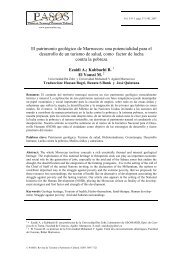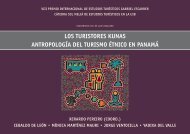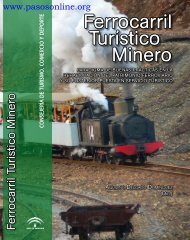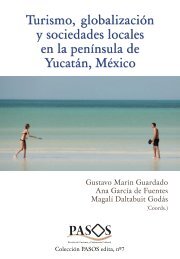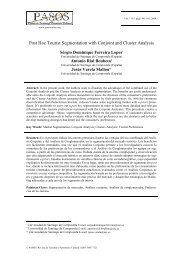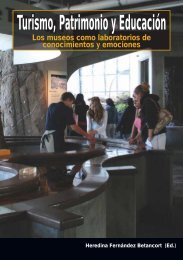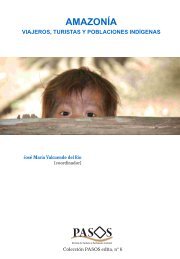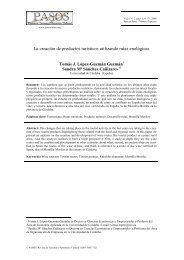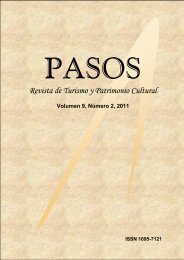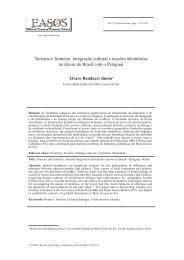Full Journal - Pasos
Full Journal - Pasos
Full Journal - Pasos
Create successful ePaper yourself
Turn your PDF publications into a flip-book with our unique Google optimized e-Paper software.
Josep-Francesc Valls; Silvia Banchini; Luis Falcón; Gerard Valls Tuñon 93<br />
cies. One of the aspects worst affected by this<br />
lack of co-ordination is treatment of segregated<br />
areas for tourists (van den Berger, 2003).<br />
In Barcelona’s case, the tourists hordes in<br />
certain areas of the city and the concentration<br />
of many of the services catering to them means<br />
some residents feel they are being pushed out of<br />
their neighbourhoods.<br />
2.1.3. Client orientation<br />
From the client orientation standpoint, cities<br />
have carried out little segmentation. There is a<br />
dearth of analysis on internal clients (residents)<br />
and little money has been spent on identifying<br />
strategic and preferred clients. The market thus<br />
seems to be based on demand rather than supply.<br />
Low differentiation has hindered analysis<br />
of the city’s clients, both internal and external,<br />
and the management required by each group.<br />
An approximation of city clients has helped us<br />
identify the following groups:<br />
Internal clients<br />
––<br />
People who live and work in Barcelona<br />
––<br />
People who live in Barcelona and work outside<br />
––<br />
People who live outside Barcelona and work<br />
in the city<br />
––<br />
Recent immigrants and their families<br />
External clients<br />
––<br />
Visitors not staying overnight who visit the<br />
city for holiday, cultural, business, health,<br />
sports, M.I.C.E. (Meetings, Incentives, Conferencing,<br />
Exhibitions) or other purposes<br />
––<br />
City Break travellers visiting for holiday,<br />
cultural, business, health, sports, M.I.C.E. or<br />
other reasons<br />
––<br />
Travellers making short stays for holiday,<br />
cultural, business, health, sports, M.I.C.E. or<br />
other reasons<br />
––<br />
Travellers making longer stays for holiday,<br />
cultural, business, health, sports, M.I.C.E. or<br />
other reasons<br />
––<br />
Travellers spending lengthy spells in the city,<br />
for example degree and master students, learning<br />
entrepreneurs, those creating start-up<br />
firms, scientists<br />
At the urban level, the contribution of ideas<br />
on co-creation appears to be extremely valuable.<br />
“The consumer is also co-producer” ... “The<br />
consumer is also co-creator of value” (Ba, Lush,<br />
2008:2). This co-creator dimension of the companies,<br />
groups, residents and visitors to the city<br />
generates value. Interaction and networking<br />
become instruments of co-creation, which are<br />
further invigorated through the role of technology.<br />
The result of this interaction of all the<br />
agents involved is the experience phenomenon;<br />
the experiential city.<br />
2.2. Barcelona’s case<br />
Barcelona’s city tourism model exhibits four<br />
success factors, which were worked on during<br />
the following stages:<br />
––<br />
1984-1987. Strategic reflection. Drawing up of<br />
the Barcelona 2000 Strategic Plan, led by the<br />
City Council and to which the private sector<br />
made a considerable contribution. The plan<br />
involved no fewer than 1,500 institutions,<br />
Civil Society and a host of experts. As a result,<br />
the plan was soundly based and provided the<br />
foundations for the Barcelona model’s success.<br />
––<br />
1987-1992. Re-invention of the city. New<br />
tourism products were created: culture, gastronomy,<br />
sport, sailing, cruise liners, health,<br />
leisure. Value was also placed on various tourism<br />
assets, among which was the notion of<br />
Barcelona as a modern, Mediterranean city<br />
and the historical capital of Catalonia. Urban<br />
renovation work was carried out and Barcelona<br />
was given the infrastructure and services<br />
fitting a modern city, including better roads<br />
and transport connections.<br />
––<br />
1992. Exploitation of the 1992 Olympic Games<br />
––<br />
1994. Set-up of a powerful institution for promoting<br />
the city—Turisme Barcelona [The Barcelona<br />
Tourist Board]—a perfect partnership<br />
between the public and private sectors (in<br />
this case, between the City Council and The<br />
Chamber of Commerce). The Board turned the<br />
fame gained by Barcelona during The Olympic<br />
Games into tourist numbers.<br />
These four, linked stages provided the impetus<br />
for mass tourism, enabling Barcelona to<br />
compete with big European cities and to cut<br />
down the vast lead held by London and Paris.<br />
The growth in tourist numbers is made clear in<br />
Figure 1, which compares figures for 1990 and<br />
2010. The number of tourists leapt from under<br />
two million a year to over seven. The proportion<br />
of holidaymakers rose from 22.7% in 1990 to<br />
50% in 2010; air passengers more than tripled<br />
to just short of 30 m a year; cruise liner passengers<br />
soared to 2.3 m; hotel rooms tripled to<br />
over 35,000; six sights attracted over 1.3 m visitors<br />
apiece. It should be borne in mind that this<br />
success was accompanied by two elements. The<br />
first was that tourist prices were reasonable.<br />
The price of a coffee, taxis, two museum tickets,<br />
a restaurant meal, a hotel room all stayed below<br />
those in London, Paris, Munich, and Rome (Ofi‐<br />
PASOS. Revista de Turismo y Patrimonio Cultural, 11(1). 2013 ISSN 1695-7121



